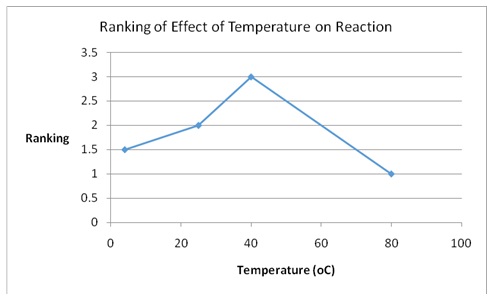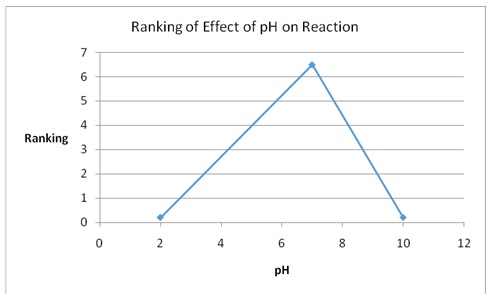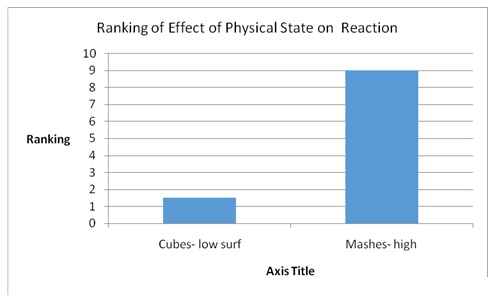Introduction
Enzymes are huge complex molecules that execute specific tasks in cells. The key role of enzymes is to improve the rates of biological reactions so that they, are well-suited to the requirements of the organism (Garrett and Grisham 23). Without these enzymes, important reactions would be too slow to sustain life (Nelson and Cox 190). The catalytic activity of most enzymes relies on the existence of tiny molecules referred to as cofactors. An enzyme with no cofactor is called an apoenzyme, whereas an enzyme with its cofactor is known as a holoenzyme (Nelson and Cox 192).
Catalase is a heme-containing enzyme that is found in plants and animals. Aerobic bacteria also have catalase in their cells (Garrett and Grisham 35). Catalase favors the conversion of hydrogen peroxide, which is a strong oxidizing agent, to water and oxygen (Garrett and Grisham 27). Hydrogen peroxide, which is a product of respiration, is damaging to the cells if left to accumulate.
Enzyme kinetics is the study of enzymatic reactions and the factors that influence them. The fundamental constituents of a reaction that is catalyzed by an enzyme are substrate, product, and the enzyme itself. The efficacy of an enzyme also depends on additional factors such as pH, temperature, salt concentrations, cofactors, activators, and inhibitors (Garrett and Grisham 430). For an enzyme to work effectively, all these features must be present at optimal concentrations or ranges. The optimal range of these conditions is specific for each type of enzyme.
Enzyme kinetics is a vital field because it helps in the understanding of enzyme activity in the course of illnesses as well as pharmacology. It provides a valid explanation for the intricate behavior of enzymes. This explanation is founded on simple chemical procedures. In certain disorders, particularly genetic ailments that pass from one family member to another, an insufficiency or entire absence of certain enzymes is usually the main cause. In other conditions, too much activity of an enzyme may be the cause. Quantifying enzyme activity in red blood cells, plasma, or tissue samples is necessary for the identification of certain conditions. Most drugs wield their biological results during interactions with enzymes (Nelson and Cox 190). Apart from medicine, enzyme kinetics is also significant in agriculture, food processing, and chemical industries.
This practical aimed at establishing the impact of metals, pH, and temperature on the reaction between catalase and hydrogen peroxide.
Materials and Methods
A potato, which contained amylase, was sliced into tiny squares of approximately 4 to 5 millimeters wide. A mark was made about 3 centimeters from the bottom of a large test tube. Subsequently, the pieces of potato were added just below the mark. Several such test tubes were prepared and kept ready for further investigations.
To establish the effect of temperature on the enzyme catalase, three Erlenmeyer flasks were filled halfway with water and placed at different temperatures. The first flask was placed in the refrigerator at less than 10 oC, whereas the second one was placed at 40 oC on a hot plate. The third flask, on the other hand, was placed on a hot plate until it attained a temperature of 80 oC. About 5 ml of 3% hydrogen peroxide was added to three test tubes in the water baths. The test tubes containing the H2O2 were put in the water baths and allowed to incubate until they attained the required temperatures. The cold, warm and hot hydrogen peroxide was added to the potato squares up to the 6 cm mark after which the height of bubbles was measured for each temperature.
In the determination of the effect of metals and co-factors on enzymatic reactions, potato squares were prepared as previously mentioned and placed in five test tubes. A solution of 1000 ppm (parts per million) FeCl3 was added to the first test-tube after which the tube was allowed to incubate for 5 minutes. In tube 2, the potato cubes were soaked with a copper solution of a concentration of 1000 ppm. The third tube contained nickel ions, whereas the fourth test tube contained manganese ions. The fifth tube, on the other hand, contained sodium ions. All five test tubes containing the metal solutions and the potato cubes were left to incubate for five minutes. Hydrogen peroxide was then added to each of the test tubes up to the 6 cm mark. The quantities of bubbles formed in each test tube were measured and recorded after one minute.
To determine the optimum pH for the enzymatic reaction between catalase and hydrogen peroxide, three test tubes were set. The potato cubes were soaked in three test tubes containing solutions with varying pH. The first test-tube contained a buffer at a pH 2, whereas the second tube contained distilled water (neutral solution or pH 7). The third test tube contained a buffer at a pH of 10. Hydrogen peroxide was then added to each of the test tubes up to the 6 cm mark after incubating for five minutes. The number of bubbles was measured and recorded after one minute.
In the determination of the effect of surface area on enzymatic reactions, the reaction between catalase and hydrogen peroxide was carried out using one test tube containing mashed potatoes and another test tube that contained potato cubes.
Results
Ranking of Effect of Temperature on Reaction

Ranking of Effect of Metals on Reaction

Ranking of Effect of pH on Reaction


Discussion
It was observed that the rate of catalase activity was highest under conditions of neutral pH. Its activity in alkaline and acidic conditions was extremely low. That meant the optimum pH for catalase was pH 7. At that pH, the concentration of hydrogen ions and hydrogen ions affected the active site of the protein in a way that gave it a shape that was most complementary to the shape of the substrate. At acidic and alkaline conditions, the enzyme probably gained and lost hydrogen ions thereby interfering with its structure. The altered conformation affected the structure of the enzyme’s active site hence affecting its ability to bind the substrate (hydrogen peroxide). Consequently, a low rate of reaction was seen.
It was also realized that catalase exhibited maximum activity at a temperature of 40 oC. Therefore, it could be deduced that the optimum temperature for catalase was 40 oC. The optimum temperature meant that there were sufficient collisions between the enzyme and substrates at that point (“Factors Affecting Enzyme Activity” par. 2). Those collisions led to the formation of enzyme-substrate complexes that were ultimately converted to products. At low temperatures (4 oC), the activity of catalase was low because the low temperatures inactivated the enzyme by lowering its kinetic energy (Hillsborough Community College 18). In addition, low temperatures reduced the number of collisions between the enzyme and the substrate hence lowering the reaction rate. High temperatures, on the other hand, resulted in low enzymatic activity because they denatured the protein by permanently altering its conformation. High temperatures destroyed important bonds such as hydrogen bonds and Van der Waals forces that were responsible for holding the protein structure in place. Consequently, the active sites could not match the structures of their substrates.
The presence of sodium ions in the reaction mixture led to a significantly high rate of reaction, whereas copper, manganese and nickel did not affect the reaction in any way. Those results showed that catalase required iron as a cofactor (Garrett and Grisham 430). Iron influenced the electron organization of molecules in the vicinity thereby aiding in hastening the transition state (Starr, Evers and Starr 79).
It was also realized that using mashed potatoes yielded significantly higher products than using potato cubes. The reason behind that observation was because catalase was localized on the surface of the potato cubes. Mashing the potatoes increased the amount of catalase that was available to catalyze the breakdown of hydrogen peroxide (Hillsborough Community College 19). As a result, a lot of products (water and gas bubbles) were formed from the numerous enzyme-substrate complexes that had been formed. Using the potato cubes, conversely, released minimal quantities of catalase leading to low rates of reaction. Those results showed that increasing the concentration of an enzyme elevated the rate of enzymatic reactions.
Conclusion
From the results of the experiment, it was concluded that catalase required a pH of 7, a temperature of 40 oC and the presence of sodium and iron ions for it to work effectively.
References
Factors Affecting Enzyme Activity. n.d. Web.
Garrett, H. Reginald and Charles M. Grisham. Biochemistry. 2nd ed. 1999. Belmont, CA: Cengage Learning. Print.
Hillsborough Community College. Characteristics of Enzymes. 2013. Web.
Nelson, L. David and Michael M. Cox. Lehninger Principles of Biochemistry. 5th ed. 2008. New York: W. H. Freeman and Company. Print.
Starr, Cecie, Christine A. Evers and Lisa Starr. Biology: Concepts and Applications without Physiology. 7th ed. 2008. Belmont, CA: Cengage Learning. Print.